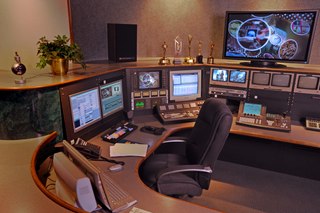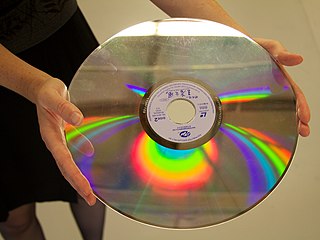Related Research Articles
A codec is a device or computer program that encodes or decodes a data stream or signal. Codec is a portmanteau of coder/decoder.

Dial-up Internet access is a form of Internet access that uses the facilities of the public switched telephone network (PSTN) to establish a connection to an Internet service provider (ISP) by dialing a telephone number on a conventional telephone line. Dial-up connections use modems to decode audio signals into data to send to a router or computer, and to encode signals from the latter two devices to send to another modem at the ISP.

Non-linear editing is a form of offline editing for audio, video, and image editing. In offline editing, the original content is not modified in the course of editing. In non-linear editing, edits are specified and modified by specialized software. A pointer-based playlist, effectively an edit decision list (EDL), for video and audio, or a directed acyclic graph for still images, is used to keep track of edits. Each time the edited audio, video, or image is rendered, played back, or accessed, it is reconstructed from the original source and the specified editing steps. Although this process is more computationally intensive than directly modifying the original content, changing the edits themselves can be almost instantaneous, and it prevents further generation loss as the audio, video, or image is edited.

Cascade Parent Limited, doing business as Alludo, is a Canadian software company headquartered in Ottawa, Ontario, specializing in graphics processing. Formerly called the Corel Corporation, the company is known for producing software titles such as CorelDRAW, and for acquiring AfterShot Pro, PaintShop Pro, Painter, Video Studio and WordPerfect.
The NewTek Video Toaster is a combination of hardware and software for the editing and production of NTSC standard-definition video. The plug-in expansion card initially worked with the Amiga 2000 computer and provides a number of BNC connectors on the exposed rear edge that provide connectivity to common analog video sources like VHS VCRs. The related software tools support video switching, luma keying, character generation, animation, and image manipulation.
Motion JPEG is a video compression format in which each video frame or interlaced field of a digital video sequence is compressed separately as a JPEG image.

The LaserDisc (LD) is a home video format and the first commercial optical disc storage medium, initially licensed, sold and marketed as MCA DiscoVision in the United States in 1978. Its diameter typically spans 30 cm (12 in). Unlike most optical-disc standards, LaserDisc is not fully digital, and instead requires the use of analog video signals.

iMovie is a free video editing application made by Apple for the Mac, the iPhone, and the iPad. It includes a range of video effects and tools like color correction and image stabilization, but is designed to be accessible to users with little or no video editing experience. iMovie's professional equivalent is Apple's Final Cut Pro X.
MacWrite is a WYSIWYG word processor application released along with the first Apple Macintosh systems in 1984. Together with MacPaint, it was one of the two original "killer applications" that propelled the adoption and popularity of the GUI in general, and the Mac in particular.
Claris International Inc., formerly FileMaker Inc., is a computer software development company formed as a subsidiary company of Apple Computer in 1987. It was given the source code and copyrights to several programs that were owned by Apple, notably MacWrite and MacPaint, in order to separate Apple's application software activities from its hardware and operating systems activities.

A camcorder is a self-contained portable electronic device with video and recording as its primary function. It is typically equipped with an articulating screen mounted on the left side, a belt to facilitate holding on the right side, hot-swappable battery facing towards the user, hot-swappable recording media, and an internally contained quiet optical zoom lens.
An edit decision list or EDL is used in the post-production process of film editing and video editing. The list contains an ordered list of reel and timecode data representing where each video clip can be obtained in order to conform the final cut.

Final Cut Pro is a professional non-linear video-editing application initially developed by Macromedia, and, since 1998, by Apple as part of its pro apps collection. Final Cut Pro allows users to import, edit, and process video footage, and output it to a wide variety of formats.
Logic Pro is a proprietary digital audio workstation (DAW) and MIDI sequencer software application for the macOS platform developed by Apple Inc. It was originally created in the early 1990s as Notator Logic, or Logic, by German software developer C-Lab which later went by Emagic. Apple acquired Emagic in 2002 and renamed Logic to Logic Pro. It was the second most popular DAW – after Ableton Live – according to a survey conducted in 2015.
Xara is an international software company founded in 1981, with an HQ in Berlin and development office in Hemel Hempstead, UK. It has developed software for a variety of computer platforms, in chronological order: the Acorn Atom, BBC Micro, Z88, Atari ST, Acorn Archimedes, Microsoft Windows, Linux, and more recently web browser-based services.

Digital cinematography is the process of capturing (recording) a motion picture using digital image sensors rather than through film stock. As digital technology has improved in recent years, this practice has become dominant. Since the mid-2010s, most movies across the world are captured as well as distributed digitally.

Avid Media Composer is a video editing application or non-linear editing software solution (NLE) developed by Avid Technology. Since its initial adoption in the 1990s, Media Composer has become the dominant non-linear editing system used by Hollywood film studios, broadcast television networks, and streaming service productions.
Blackbird is an integrated internet video platform, video editing software, covering non-linear editing and publishing for broadcast, web and mobile.
EditDV was a video editing software released by Radius, Inc. in late 1997 as an evolution of their earlier Radius Edit product. EditDV was one of the first products providing professional-quality editing of the then new DV format at a relatively affordable cost and was named "The Best Video Tool of 1998". Originally EditDV was available for Macintosh only but in February 2000 EditDV 2.0 for Windows was released. With version 3.0 EditDV's name was changed to CineStream.
References
- ↑ Ohanian, Thomas A.; Phillips, Michael E. (2000). Digital Filmmaking: The Changing Art and Craft of Making Motion Pictures. Focal Press. ISBN 978-0-240-80427-9.
- ↑ D/Vision Pro 2.2 User Manual
- ↑ "D/VISION PRO - MovieMaker Magazine". www.moviemaker.com. 1995-04-07. Retrieved 2024-01-19.
- ↑ Doyle, Bob (January 23, 2022). "Desktop Video: Digital Nonlinear Editing". Videomaker. Archived from the original on January 23, 2022.
- ↑ "Editor's Wake- discreet edit* – The DIT Spot" . Retrieved 2024-01-19.